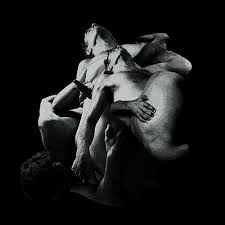Punish, Honey. Pain, pleasure. The comma in the title of Vessel’s second album denoting some correspondence rather than opposition between the two. On the album’s cover, writhing marmorated bodies are locked in the throes of what could equally be ecstasy or agony. In Three Essays On The Theory Of Sexuality, Freud hypothesised that those seemingly conflicting sensations might be interrelated. "Anyone who takes pleasure in causing others pain in a sexual relationship is also capable of enjoying as pleasure the pain that can arise from his own sexual relations," he concludes in a section addressing sadism and masochism. It’s this slippage between pain and pleasure which informs not just the imagery of Punish, Honey but also its sonics.
Seb Gainsborough’s own definition of Vessel as "physical music to be played loud on sound systems", has similarly framed his work in terms of bodily experience. His debut, Order Of Noise, released in 2012, was exactly that: a series of bruising, concessive takes on techno and dub. That physicality has also come to inform the creation of Punish, Honey. Speaking to the Quietus’ Rory Gibb in The Wire last year, Gainsborough described the liberating nature of switching off his computer and recording live with no overdubs. Within dance music, the rejection of software for hardware has become a firmly entrenched narrative, suggesting a return of the repressed. But here the liberation Gainsborough ascribes to working with physical instruments comes from an instinctive need to experiment by introducing more variables (and then "start fucking with them" as he goes on to explain) rather than any fetishism for components.
On Punish Honey, Gainsborough has realised this desire for tactility. His approach to the album’s production resembles that of a Foley artist, with most of the album’s sounds created with a number of handmade instruments. But equally, the album seems to be a deconstruction of that approach. On the opening track ‘Febrile’, the first crash of cymbal comes after 12 seconds of silence: jolting and mocking us like a rimshot punctuating a joke at our expense. As the percussion comes to a crescendo, both muscle and metal are worked to their limits. In much the same way, the screeching and harsh string sounds – apparently created from handmade "harmonic guitars" – on tracks like ‘Drowned In Water And Light’ and ‘Kin To Coal’ give an immediate sense of the tension and force being applied to them. Gainsborough seems to be testing not only what his crude instrumentation can withstand, but also his listeners.
For all the physical exertion though, the album sounds surprisingly sexless and apathetic at times. The suggestively titled ‘Red Sex’ turns out to be something of misnomer, the undulating pitch of its synth line rather more nauseating and sickly than carnal. Equally, the album’s attempt at evoking the natural world makes for its weakest moment. ‘Black Leaves And Fallen Branches’ is saturated with mimicry of animal calls, air horns and bells but devoid of any structure. Other experiments with found sounds are more successful, such as ‘Drowned In Water And Light’, in which dreamlike melodic chimes, nostalgically recalling carousels and music boxes, abruptly transition into grinding noise and sub-bass. It’s only on the final three tracks that the pressure that has been building throughout the album finally gives way on the ear-splitting frequencies of ‘Kin To Coal’.
On his debut, Gainsborough experimented within the nexus of dance music genres centred around Bristol. Punish, Honey is step a further removed from that context, the album’s treatment of those forms ever closer to noise and post-noise. But despite Gainsborough’s indifference towards music intended for club spaces, the way he chooses to conceptualise his productions as body music links him to dance floor. In that sense he shares the same – and often the only – concern of the most functionalist of dance musics even as he resists being aligned with those musics.
Instead, Punish, Honey interrogates the relationship between the body and dance music through the universal experiences of pain and pleasure. The latter, coming to represent the punishment inflicted on the sound objects that were created specifically for the album, subjected to all sorts of extremes to produce certain sounds. But as well as providing a way to articulate Gainsborough’s own position as a producer, it’s also a way to think of our own engagement as listeners. We are caught in the brutality of the instrumentation even though the cruelty is for our own gratification. So we find ourselves, as Freud suggests, occupying at once the position of sadist and masochist; taking vicarious pleasure in the destruction, while being scourged by its sounds.
<div class="fb-comments" data-href="http://thequietus.com/articles/16114-vessel-punish-honey-review” data-width="550">


